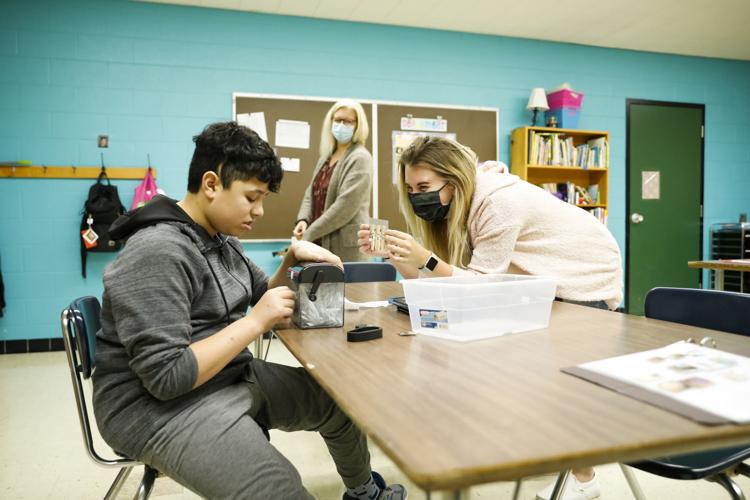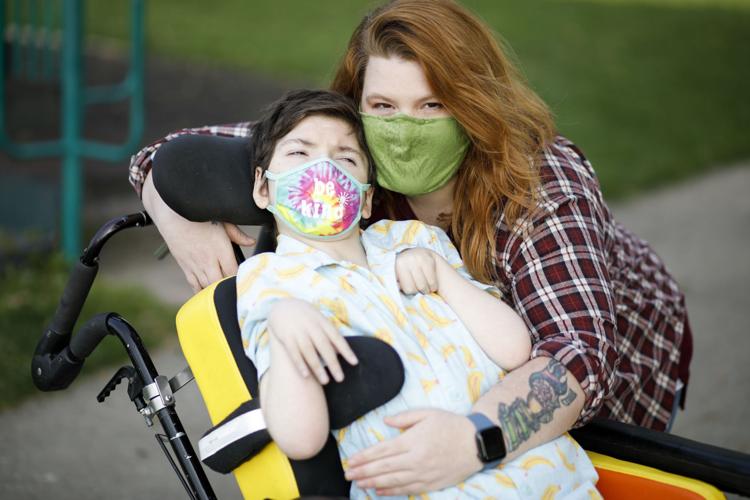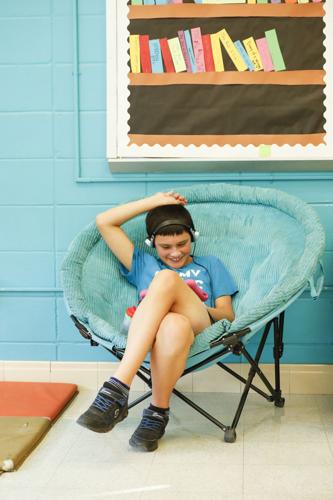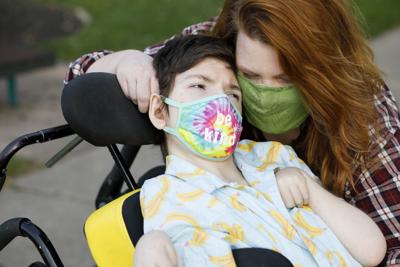Leani Tell is starting kindergarten this year.
Like thousands of her peers, she’s doing so from home. Unlike most of them, she would have been at home even without the pandemic that will keep Madison Metropolitan School District buildings mostly closed through at least Oct. 31.
Leani, 4, has spinal muscular atrophy, which causes symptoms similar to those that ALS causes in adults. It also means she is especially susceptible to respiratory infections, with even colds sending her to the hospital for days.
“I didn’t really care a whole lot if kids were going back to school or not because she was never going to be going in-person,” said her mother, Nichole Fritts. “She was always going to be virtual because of her health status.”
But the pandemic is hurting Leani’s education anyway, as the school district is not providing an in-person educational aide as outlined in her Individualized Education Program (IEP) created in the spring. That leaves Fritts, her husband and part-time, in-home nurses they pay for out-of-pocket to guide her health and schooling.
“I would love for there to be someone that is actually trained for them to actually go by her IEP for school to be more accessible for her,” Fritts said. “There’s times where I’m juggling being a mom, a nurse and a student aide and it is absolutely impossible to do all three of those effectively.”
It’s an example of the outsized effects the pandemic has had on families of the nearly 4,000 MMSD students with disabilities since schools closed March 13.
Many students with disabilities lost progress in the months at home, as their routines were disrupted and the district struggled to adapt their IEPs to a virtual environment and meet its legal obligations under federal law. IEPs can include learning accommodations, therapies and allowances for one-on-one time with a staff member for disabilities that range from ADHD to cerebral palsy.
“The thought of actually shifting to virtual, we’re just absolutely not set up for that as a larger system and in particular for students with very complex disabilities,” said John Harper, executive director of MMSD student services.
“We’re just absolutely not well-prepared for (that) given how rapidly this all evolved.”
Martha Siravo, whose daughter Jaz has cerebral palsy, found herself in her own challenging situation in March.
“I literally just threw myself into all the roles that were removed and literally became her school PT, OT, speech and special ed within the house,” Siravo said. “We didn’t drop anything, but it took a long time to create that new connection.”

Nichole Fritts talks with her daughter, Leani Tell, as they finish a virtual learning lesson for the day at their home in Madison.
Most of the nine parents who spoke with the Cap Times did not direct their disappointment with the spring toward school or district staff, who they acknowledged were facing an extreme challenge. Harper wasn’t much happier, despite what he considered best efforts from staff.
“It has been filled with so many gut-wrenching situations,” Harper said. “It’s really unpleasant to look in the rearview mirror.”
This fall is supposed to be better, with a summer to plan and reflect on what worked and what didn’t. In-person instruction began Sept. 8 for select students with disabilities who require it to fulfill their IEP goals, even as most will remain entirely virtual like the rest of the student body through at least October.
The in-person opportunities for those who have them, though, have been an early sign of hope for parents. Harper estimated that applies to about 25 students at each high school, six to 12 at each middle school and three to nine at each elementary school.
“In our view, it’s emotionally healthier for everybody,” said Ben Knox, whose fifth-grade son Andrew has autism and had a hard time engaging with virtual learning in the spring. “So far, it’s off to a good start.”
As Fritts spoke with a reporter via Zoom, she turned the camera to Leani on the third day of the school year. The 4-year-old, helped by a nurse, was lying in her bed watching her special education teacher sing “Heads, shoulders, knees and toes” on an iPad screen, with a device that allows Leani to use her eyes to communicate nearby.
“I know it’s chaotic for everybody, everybody has their own challenges, everybody’s job has been affected,” Fritts said. “Everybody has a story at this point of COVID challenges, and this is ours.”
‘Hold on and hope for the best’
The sudden school closure in the spring was especially challenging for parents of children with disabilities.
“Honestly, it was just a hold on and hope for the best kind of thing,” said Anna Hauser, whose 15-year-old son Zavier has cerebral palsy. “Everything happened so big and so fast.”
Hauser, who has two younger children as well, said it was a tough transition that included her performing therapies with her son while getting advice over Zoom from therapists. She said the months took a mental and emotional toll on the whole family.
“We were really just stuck in a two-bedroom apartment with four people,” she said. “It was a lot for them. We just kind of watched them fade into a lot of quiet. I didn’t realize how severe the effect was until I heard my kiddo laugh for the first time in two months.”

Anna Hauser embraces her son Zavier, who attends East High School for two hours a day, two days a week. After a difficult spring, the "beginning of the year is off to a really good start for us," she wrote in an email.
It was a difficult few months for Ron Giordan, as well. Giordan’s son, Gio, was a nonverbal eighth grader at Jefferson Middle School. Gio wouldn’t last more than 15 minutes on a Zoom meeting, whether it was a general education class or time with the special education teachers he had gotten to know in his three years at the school.
“It was horrible, I’m not going to lie,” Giordan said.
By the time summer ended, Giordan and his wife were worried about how much Gio had regressed in the time school buildings were closed. It was especially concerning as Gio prepared to go to a new school as a freshman at Memorial High School, where he didn’t know the staff who would work most closely with him.
“We feel that he’s lost at least two years of what he had learned at Jefferson in these few months,” Giordan said. “We can see it in him.”
[Q&A: Maxine McKinney de Royston says virtual instruction is a chance to reimagine education]

Anna Hauser embraces her son Zavier, who attends East High School for two hours a day, two days a week.
Back and forth
When Anna Moffit met with her son’s IEP team the morning of Aug. 21, the group agreed on a plan to have her seventh-grade son Felix go to Cherokee Heights Middle School for two hours a day, four days a week for in-person services.
By 5:30 p.m., that plan seemed unlikely, as Public Health Madison & Dane County issued an order prohibiting in-person instruction for grades 3-12 that did not include any exemptions for students with disabilities.
“We were just kind of playing it by ear,” Moffit said of the weeks that followed. “Obviously it was stressful, especially when we had just gotten a plan in place and then the directive came out from public health.”
Just days after the order, MMSD’s Harper told the Cap Times the district had been planning since July for some in-person work with certain students. He was disappointed with the order and hopeful PHMDC would reconsider an exception.
As September began without any word of a change from PHMDC, Harper said the district was “very, very close to informing families that we weren’t able to” do in-person work.
On Sept. 2 — less than a week before the school year would begin — PHMDC issued an amendment, allowing for some in-person instruction for students with disabilities. Weeks later, the entire public health order was put on hold by the state Supreme Court.
“It was the difference between literally hundreds of students in grades 3 through 12 that would not have had the opportunity for any kind of in-person,” Harper said of the amendment. “It was a very significant turn of events for us.”
PHMDC communications supervisor Sarah Mattes wrote in a statement that, “After discussion with the Department of Public Instruction, it became evident that some of these services for students with disabilities/IEPs cannot be provided virtually,” which led to the change.
Knox, father of fifth grader Andrew, called it a “week-and-a-half of high stress” as they waited for information, but he said now that school has begun and his son is able to do some in-person work, they’ve moved forward.
“We’re not holding onto that stress and holding it against anyone,” he said. “We’re grateful for the advocacy of school district officials from around Dane County who went to bat for students with special needs with the county.”

Special education assistant Terri Alexander works with freshman Gio Giordan during an in-person lessons at James Madison Memorial High School.
New beginning for fall
Now that school is in session, those whose children can go in person are already feeling a sense of relief.
“When he’s home, he’s at home and he does not want to work,” Giordan said of his son. “Like when you’re at home you don’t want to work.
“For us to integrate school at home isn’t something that he can compute. He’s like, ‘But I’m at home, this doesn’t make sense.’”
Moffit said her son Felix was up at 1 a.m. before his first day returning to in-person school Sept. 14. When she dropped him off, she watched him run through the door with excitement.
“He did great,” she said. “It was really good. He had a wonderful transition.”
Making in-person instruction work requires staff who are comfortable being in a building with students — some of whom can’t wear a mask for medical reasons. Harper said the district is providing the proper personal protective equipment for those staff and limiting what students would be in-person to those who really need it for instruction.
“We have targeted students who are a bit more, I would describe as being dependent learners,” he said. “There will certainly be some related services provided, but the vast majority is going to be actual teachers teaching.”
Just before the year began, Harper outlined the challenges of putting together a plan for fall — from figuring out how to make in-person work safely to scheduling, staffing and continuing to provide support for those who would remain only online.
“It’s an incredible jigsaw puzzle that we assemble and it just takes a lot of time and brute force to figure out student need and staffing supports while also being cognizant of the virtual educational supports that need to take place for all other students,” he said. “That’s always the beginning part of the year challenge, and I would say it’s a bit more this year than most.”
Hauser, whose East High School son is able to go in-person for two hours a day, two days a week, wrote in an email that the “beginning of the year is off to a really good start for us.”
“I’m seeing a lot more inclusivity and organization to make sure he is included,” she wrote.

Speech and language pathologist Liz Schoonveld, center, and special education teacher Paige Ohlendorf work with freshman Gio Giordan during in-person lessons at James Madison Memorial High School.
['It's been nuts': McFarland family makes, sells iPad stands to help with virtual learning]
Not a universal solution
Without entirely in-person school for everyone, no system was going to meet every need.
In Leani’s case, the IEP was written in the spring with the idea that school would be in-person in the fall — something Fritts said she questioned at the time. Harper, commenting generally on sending staff into homes during a pandemic, said doing so would require better overall public health metrics.
“That’s sort of the line right now that we’re saying, ‘That’s not going to happen right now,’” he said. “That’s a risk to both student and staff, family, community.”
Siravo, whose daughter is not receiving in-person services, said this fall’s online schedule has been a lot busier than in the spring. She said the first week was “overwhelming” for her and Jaz, and she’s unsure how much time her daughter will end up spending in the general education Zoom classrooms given the therapies and everything else that require their time.
“I have a feeling we’ll end up just focusing on her one-on-ones and maybe looking at the specials (art, music, etc.) every now and again,” Siravo said. “But I can’t possibly do all of her special education stuff, all of her therapy stuff.”
Larissa Joanna, whose son Gianni Mendoza has ADHD and a speech delay, is concerned about how her kindergartner is handling virtual learning. He loved in-person 4K last year before the pandemic, but stopped receiving some of his speech therapy services when teaching moved online.
He’s had some one-on-one sessions to begin this year, Joanna said, and those have gone well. But still, she worries about where he’ll be by first grade next year, a critical time for building basics like reading, writing and math, she said.
“I don’t know how it will go from now,” she said. “I think it will be OK, but this is something that’s just so hard to think about. This is going to be for a long time.”
For Fritts, it’s a lot of learning on the fly what student aides do every day — like rephrasing a directive from the classroom teacher to “stand up and we’re going to dance now,” an activity her daughter can’t take part in.
“It’s definitely been a challenge trying to adapt things for her physically,” Fritts said. “I’m not a student aide, I’m not a special ed teacher. So I’m just kind of a special needs parent trying to guess on how to make things appropriate for her.”

Felix Moffit is a seventh grader at Cherokee Heights Middle School. Special education assistant Jazmin Diaz works with Felix, who attends in-person school as part of his Individualized Education Program.
[New Madison elementary school would go on Badger Rock site if referendum approved]
Legal challenge
Services for students with disabilities are protected under federal law, which requires districts to provide a “Free and Appropriate Education” to them.
“At its basic level, it’s that the student is meaningfully progressing on their IEP goals and applicable standards,” Harper explained.
That presented a problem in the spring, when there were elements of IEPs that weren’t implemented in the new, virtual system. The district sent parents a “Prior Written Notice” document outlining what IEP services it would provide, and which ones it wouldn’t, during the spring.
Jeff Spitzer-Resnick, a Madison disability rights attorney, said MMSD’s actions — which were similar to those taken by other districts — “broke the law” and hurt students with disabilities.

Felix Moffit is a seventh grader at Cherokee Heights Middle School.
“MMSD just unilaterally decided what the changes were going to be,” he said. “In general, the changes basically gave short shrift to students with disabilities.”
Harper said that the district tried to involve parents in those conversations when possible, but he acknowledged that was not universal.
“Were there some (situations) where we had to make a decision because we weren’t able to connect with the parents to have a collaboratively developed PWN? Undoubtedly that happened,” he said.
When asked if he thought the district had broken the law in the spring, Harper said the district consulted with officials from DPI and said what happened with school closures was “almost inconceivable” before March.
“There’s nothing in IDEA (federal law) that has any kind of parameters of this type of event,” he said. “I feel very confident in saying we did the best we could do under the circumstances given an almost immediate shut down of our educational system.”
He said staff understand the legal requirements behind the work they’re doing, but they hope to do much more than the bare minimum.
“We will have to just continue to create and innovate how we’re going to meet our legal obligations as well as what we feel is our moral obligations to provide a really high-quality educational experience,” Harper said.
Once in-person learning returns, Harper expects a flurry of “additional services” — meaning extra efforts to make up for what was lost throughout virtual learning — that are also required under federal law if steps are missed in an IEP implementation.
“That’s an uphill battle as well, given we’re starting another virtual education environment,” he said. “Had we begun with in-person, that would’ve enabled us to somewhat re-establish some of the typical ways of working and allow for additional services and opportunities.”
Giordan is unsure how the district can “fulfill the federal law” through this pandemic, but he is mostly focused on one goal for his son.
“We’re looking for the same thing as parents of regular education kids get every day, and that is a chance to learn and be with their peers and interact,” he said.










